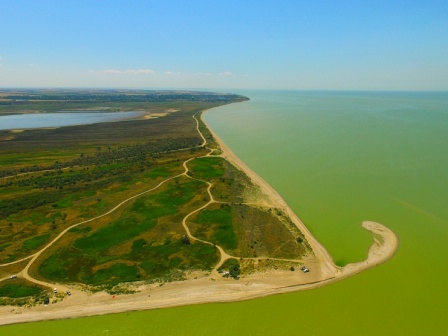Resource base
Climate
- The average annual air temperature is +9.70 °C. The absolute maximum temperature was recorded in July and August (+39–40°C), the absolute minimum (-32–34 °C) was recorded in December and January.
- The area experiences strong winds from the northeast, east, west, and southwest, occasionally escalating into storms. The southwesterly winds can also develop into intense squalls. The average annual wind speed is 5.9 m/sec.
- The area experiences strong winds from the northeast, east, west, and southwest, occasionally escalating into storms. The southwesterly winds can also develop into intense squalls.
Mineral
resources
Fertile
lands
Recreational resources
- Glafirovsky beach is located on the eastern shore of the Sea of Azov
- Spring in honor of the “Unfading Flower” Icon of the Mother of God

The Azov Spits Nature Park
Area of protected areas: 5,958,0409 hectares.
Location of the protected area: Glafirovskoye and Shabelskoye rural settlements of Scherbinovsk district
The natural park’s territory covers parts of the Sazalnikskaya and Glafirovskaya spits, along with the surrounding water area of Taganrog Bay and Yeisky Estuary. These clusters are sea spits bordered by the waters of Taganrog Bay and Yeisky Liman. They consist of marine sediments, including layers of sand, detritus, and shells.
The Green Islands, with their large colonies of gulls and copepods, and Lake Sazalnikskoye (Long, Dolgoye) are crucial for bird conservation in the region.
The natural park’s territory is crucial for preserving the population of multicolored lizards, which are commonly seen on the Sazalnikskaya Spit.
The Azov Spits Nature Park is known for its rich variety and unique flora. It plays an important role in safeguarding plants listed in the Red Books of the Russian Federation and Krasnodar Territory.

The source in honor of the “Unfading Flower” Icon of the Mother of God
In the village of Yekaterinovka, on the low-lying, overgrown bank of the river Yeya, a spring of pure water was discovered in ancient times. It gained fame among the locals for its miraculous healing properties. It was named after the “Unfading Flower” Icon of the Mother of God, where the Mother of God is depicted with Jesus and a snow-white lily. The spring is well-known and respected in the area, serving as both a sacred site and an Orthodox attraction. People come here seeking health benefits, help in the fight against diseases, or out of simple curiosity.


